Production Possibility Frontiers Assignment Help
The basic resources available to a society are often referred to as factors of production, Or simply factors. The three key factors of production are land, labour, and capital. The process that transforms scarce resources into useful goods and services is called production.
Resources or factors of production are the inputs into the process of production; goods and services of value to households are the outputs of the process of production.
Things that are produced and then used in the production of other goods and services are called capital resources, or simply capital.
The production possibility frontier (PPF) is a graph that shows all possible combinations of goods and services that can be produced if all of a society’s factors of production and resources are used efficiently. PPF is a tool that depicts economic choices and principles of constrained choice, opportunity cost, and scarcity.
On the Y-axis, we measure the quantity of capital goods produced. On the X-axis, we measure the quantity of consumer goods.
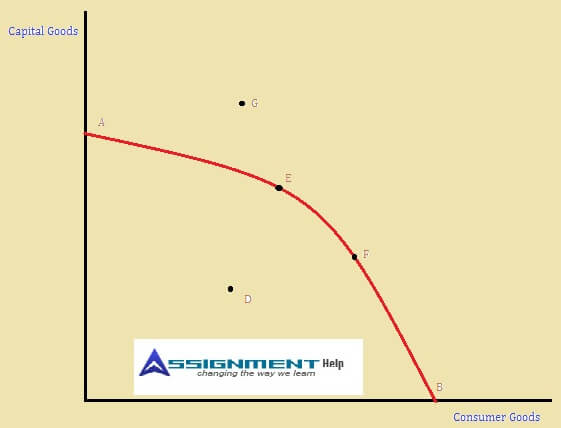
- All points below and to the left of the curve represent combinations of capital and consumer goods that are possible for the society given the resources available and existing technology.
- Points above and to the right of the curve, such as point G, represent combinations that cannot be produced.
- If an economy were to end up at point A on the graph, it would be producing no consumer goods at all; all resources would be used for the production of capital.
- If an economy were to end up at point B, it would be devoting all its resources to the production of consumer goods and none of its resources to the formation of capital.
- Points that are actually on the PPF are points of both full resource employment and production efficiency. Resources are not going unused, and there is no waste.
- Points that lie inside to the left of the PPF but that are not on the PPF represent either unemployment of resources or production inefficiency.
- An economy producing at point D can produce more capital goods as well as more consumer goods, for example, by moving to point E. This is possible because resources are not fully employed at point D or are not being used efficiently.
- Periods of unemployment correspond to points inside the PPF, points such as D. Moving onto the frontier from a point such as D means achieving full employment of resources.
- Although an economy may be operating with full employment of its land, labour, and capital resources, it may still be operating inside its PPF (at a point such as D). It could be using those resources inefficiently.
- Efficient Mix of Output: To be efficient, an economy must produce what people want. This means that in addition to operating on the PPF, the economy must be operating at the right point on the PPF. This is referred to as output efficiency, in contrast to production efficiency. Points E and F are points of production efficiency and full employment. Whether E is more or less efficient than F, however, depends on the preferences of members of Society.
Production Possibility Frontiers Assignment Help By Online Tutoring and Guided Sessions at AssignmentHelp.Net
Need help with principles of economics numerical problems based on production possibility curves, trade and opportunity cost? Book online Principles of Microeconomics Homework Help now!
Negative Slope of PPF and Opportunity Cost
Society can choose only one point on the curve. Because a society’s choices are constrained by available resources and existing technology, when those resources are fully and efficiently employed, it can produce more capital goods only by reducing production of consumer goods.
The opportunity cost of each additional capital good produced is the forgone production of consumer goods. This scarcity, trade-off and opportunity cost is illustrated by the negative slope of the PPF.
The slope of the PPF is the ratio of the change in capital goods to the change in consumer goods. This value of the slope of PPF is negative. The value of the slope of an economy’s PPF is called the marginal rate of transformation (MRT).
The Law of Increasing Opportunity Cost
The cost of producing capital goods-measured in terms of consumer goods forgone- increases as we increasingly shift production factors away from production of consumer goods and to increase the production of capital goods. This is the reason economy’s PPF is bowed out to the origin (concave) curve.
Each successive increment of one good comes at a higher opportunity cost measured in terms of the other good forgone.
An efficient economy is one that produces the things that people want at the least cost. Production efficiency is a state in which a given mix of outputs is produced at the least cost.)
Economic Growth & PPF
Economic growth is characterized by an increase in the total output of an economy. It occurs when a society acquires new resources or learns to produce more with existing resources. New resources may mean a larger labor force or an increased capital stock. The production and use of new machinery and equipment (capital) increase workers’ productivity.
Improved productivity also comes from technological change and innovation, the discovery and application of new, more efficient production techniques.
Increases such as these shift the PPF up and to the right.
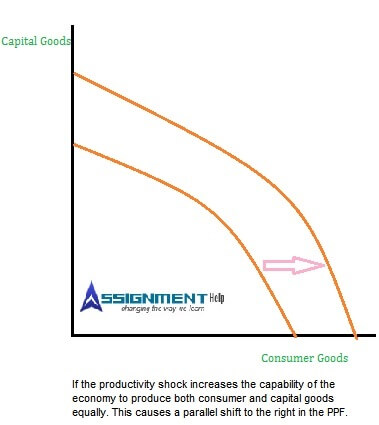
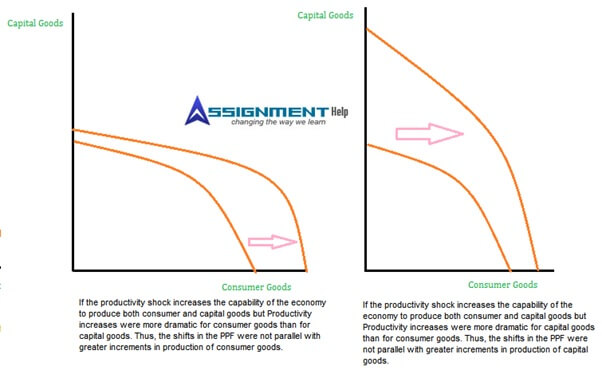
One Person Economy
Robinson Crusoe is assumed to be shipwrecked on a deserted island. Crusoe has only two activities to participate in – collect fruits to eat or collect wood to build his house.
The basic assumptions of the Robinson Crusoe economy are as follows:
- The island is cut off from the rest of the world (and hence cannot trade)
- There is only a single economic agent (Crusoe himself)
- All commodities on the island have to be produced or found from existing stocks
That is, although Robinson will get whatever he produces, he still must decide how to allocate the island’s resources, what to produce, and how and when to produce it.
Robinson is constrained by time, his physical condition, his knowledge, his skills, and the resources and climate of the island. Given that resources are limited; Robinson must decide how to best use them to satisfy his wants.
Given the scarcity of time and resources, if Robinson decides to collect wood, he will have less time to collect fruits. He faces a trade-off between wood and fruit (or between food and shelter)
Two (or more) Person economy: Specialization and Trade
Suppose that another survivor appears on the island, Man Friday. Robinson and Friday will have different preferences in terms of whether to collect fruits or to collect wood. Also they will have different skills and knowledge. So Robinson and Friday will need to make certain decisions such as:
Should only one of them take charge and decide for both of them?
Or should the two of them cooperate, to split the planning as well as the production duties?
Or should they live alone individually at opposite ends of the island? Even if they live apart, can they may take advantage of each other’s presence by specializing and trading?
All these possibilities are again decisions regarding what to produce, how to produce it, and who gets it.
Specialization, Exchange and Comparative Advantage
David Ricardo, a British economist, formalized these decisions in Ricardo’s theory of comparative advantage, according to which, specialization and free trade will benefit all trading parties, even when some are “absolutely” more efficient producers than others.
Suppose that Robinson and Friday have only two tasks to accomplish each week: gathering fruits to eat and cutting woods to build houses.
Scene 1:
If Friday could cut more logs than Robinson in 1 day and Robinson could gather more fruits than Friday could, specialization would clearly lead to more total production. Both would benefit if Friday only cuts woods and Robinson only gathers fruits, as long as they can trade.
Scene 2:
Suppose that Robinson is slow and lazy in his fruit gathering and that Friday is better at cutting woods and gathering fruits. It might look like since Friday is better at both jobs, he should do everything. But that is not right. Friday only has limited time in a day (Scarcity) and every hour he spends collecting woods, he has to forgo collecting fruits. Thus in every hour, Friday’s opportunity cost of collecting woods is the fruits which he could have collected in that hour.
Based on this analysis of scarcity, trade-off and opportunity cost, Ricardo’s theory of comparative advantage states that if Robinson and Friday divide the work of the island and how much they will gain from specializing and exchanging even if, as in this example, one party is absolutely better at everything than the other party.
Suppose Friday can cut 10 woods per day and Robinson can cut only 4. Also suppose Friday can gather 10 fruits per day and Robinson can gather only 8.
| Fruit | Wood | |
|---|---|---|
| Robinson | 8 | 4 |
| Friday | 10 | 10 |
A producer has an absolute advantage over another in the production of a good or service if he or she can produce the good or service using fewer resources, including time.
Since Friday can cut more woods per day than Robinson, we say that he has an absolute advantage in the production of woods. Similarly, Friday also has an absolute advantage over Robinson in collection of fruits.
Despite having absolute advantage in both the goods, it will be beneficial for Friday to cooperate with Robinson and benefit through specialisation and exchange because Friday’s time is limited and this creates an opportunity cost. Ricardo explains this on the basis of comparative advantage.
A producer has a comparative advantage over another in the production of a good or service if he or she can produce the good or service at a lower opportunity cost.
Calculation of Opportunity Costs
Robinson can collect 8 fruits per day, or he can cut 4 woods. To collect 8 additional fruits, he must give up cutting 4 woods. Thus, for Robinson, the opportunity cost of 1 fruits is ½ woods.
Friday can collect 10 fruits per day, or he can cut 10 logs. Friday thus gives up 1 wood for each additional fruit; so for Friday, the opportunity cost of 1 fruit is 1 wood.
Thus, Robinson has a comparative advantage over Friday in the collection of Fruits because he gives up only ½ woods for 1 extra fruit, whereas Friday gives up 1 wood.
Think now about what Friday must give up in terms of fruits to get 10 woods. To produce 10 woods he must work a whole day. If he spends a day cutting 10 woods, he gives up a day of gathering 10 fruits. Thus, for Friday, the opportunity cost of 1 woods is 1 fruits.
Similarly, to produce 4 woods, Robinson must work 1 full day cutting only woods. For each day he cuts woods, he gives up 8 fruits. He thus gives up 2 fruits for each wood.
So for Robinson, the opportunity cost of 1woods is 2 fruits.
Friday has a comparative advantage over Robinson in the production of woods since he gives up only 1 fruit for an additional 1 wood, whereas Robinson gives up 2 fruits for one extra wood.
Gains from Specialization and Exchange
If Friday works alone, in a 30-day month he can produce 150 woods and 150 fruits, devoting 15 days to each task.
Suppose, when alone, Robinson spends 10 days on fruits and 20 days on woods. This yields 80 fruits (10 days * 8 fruits per day) and 80 woods (20 days * 4 woods per day). Sum total, they produce 230 woods and 230 fruits.
If Friday and Robinson specialise in the activities in which they have comparative advantages, then Robinson should spend all his time on fruit and he produces 240 fruits in a month (30 days* 8 fruits per day). If Friday spends 30 days on woods, he produces 300 woods (30 days*10 woods per day). Between the two, they produce 300 woods and 240 fruits, which is more than the 230 woods and 230 fruits they produced when not specializing.
Thus, by specializing in the production of the good in which they enjoyed a comparative advantage, there are more of both goods.
Friday could trade 100 of his woods to Robinson for 155 fruits. This would leave him with 200 woods and 155 fruits, which is more than the 150 of each he could produce on his own.
Robinson would specialize completely in fruits, producing 240 fruits. Trading 155 fruits to Friday for 100 woods leaves him with 100 woods and 85 fruits, which is more than the 80 of each he could produce on his own.
Thus with specialisation and exchange based on comparative advantage, it is possible for both parties to enjoy mutual benefits, even though one party has an absolute advantage in production of all goods and services.
USING PRODUCTION POSSIBILITIES FRONTIERS TO DEMONSTRATE THEORY OF COMPARATIVE ADVANTAGE
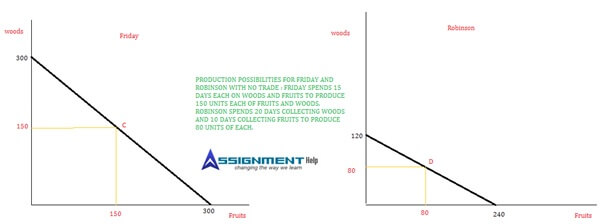
The figure above shows all of the combinations of woods and fruits that Friday and Robinson can produce by himself. If Friday spends all 30 days each month on woods, he produces 300 woods and no fruits. If he spends all 30 days on fruits, he produces 300 fruits and no woods. If he spends 15 days on woods and 15 days on fruits, he produces 150 of each (point C).
The figure on right shows all of the combinations of woods and fruits that Robinson can produce by himself. If he spends all 30 days each month on woods, he produces 120 woods and no fruit. If he spends all 30 days on fruits, he produces 240 fruits and no woods. If he spends 20 days on woods and 10 days on fruits, he produces 80 of each (point D).
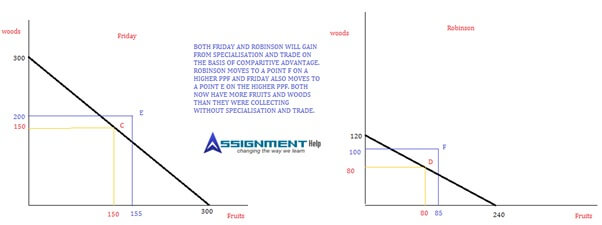
By specializing and engaging in trade, Friday and Robinson can move beyond their own production possibilities.
If Robinson spends all his time producing fruits, he will produce 240 fruits and no woods. If he can trade 155 of his fruits with Friday for 100 woods, he will end up with 85 fruits and 100 woods. This would be a movement from a point D to a point F which is on a higher PPF.
If Friday spends 30 days cutting woods, he will produce 300 woods and 0 fruits. If he can trade 100 of her woods to Robinson for 155 fruits, he will end up with 200 woods and 155 fruits. Thus Friday can also move from point C to a point E on a higher PPF.
Both are better off. Both move beyond their individual production possibilities.
Looking for help with understanding concepts like Production Possibility Frontiers, Scarcity, opportunity cost, comparative advantage, absolute advantage or Ricardian theory of International Trade? Get in touch with AssignmentHelp’s online Microeconomics tutor for all your homework help problems. Our tutors are experts in basic, intermediate and advanced all levels of microeconomic theories whether they are simple concepts of principles of microeconomics or advanced economic theory problems of social choice, game theory or welfare economics. Get fast, affordable and reliable microeconomics homework help from the comfort of your home. Order Online Microeconomics homework helpnow and master all concepts of Microeconomics.


